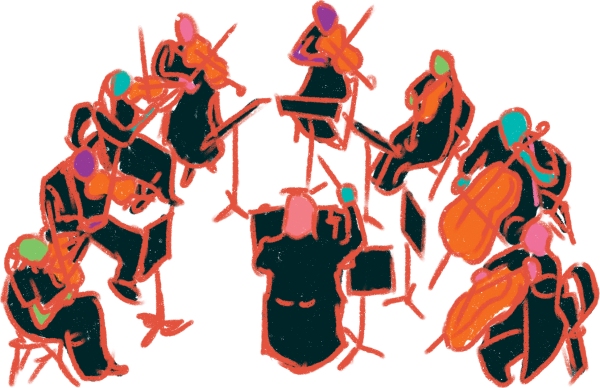The Bedroom Ensemble: Inside Virtual Orchestra
November 15, 2020
With COVID-19 cases still in high numbers, many students remain quarantined and learning virtually. While this has presented difficulties for LASA Orchestra, having to walk around campus carrying a heavy instrument is now a thing of the past, at least temporarily, with students now able to play virtually from the comfort of their bedrooms.
Classes with a foundation of teamwork like fine arts and sports have had to adapt to not being able to play together in person. For Orchestra, a lot of time is spent on learning and perfecting music, which is harder to do as an ensemble over Zoom. Sophomore Julia Ding said Orchestra hasn’t been the same.
“At home, we play along with a recording rather than with other students,” Ding said. “This poses technical issues due to lag and it’s quite different than playing with a real orchestra.”
Ding has also experienced benefits from playing virtually, though. She said she has less to carry around throughout the day and a greater freedom with instruments.
“As a cello player, it’s harder to bring our instruments to and from school,” Ding said. “In normal circumstances, cello players would, most of the time, play school instruments, which, most of the time, were worse than our home instruments. At home, we always have access to our own instruments.”
On the other hand, Sophomore Aileen Chow said that a recurring challenge at home is internet connection.
“[Challenges] I face at home are sometimes technical and internet problems,” Chow said. “Sometimes, it would take a long time to join a Zoom meeting, or my computer would not turn on because it’s doing updates.”
Ding said that a big part of Orchestra she misses is the social aspect. However, while time to talk has been replaced by staring at a computer screen, school has been a less chaotic experience, according to Ding.
“Overall, online classes are going pretty well,” Ding said. “I miss the social aspect of being in class, but being able to save time commuting has ultimately led to online school being a lot less stressful.”
For Orchestra director Luzvic Backstrom, it’s been very different to teach online than in school. She said she is used to working with all the students at once rather than hearing everyone one at a time, making it more difficult to perfect the ensemble.
“All our groups…normally work in ensembles, and not having that opportunity is the main difference,” Backstrom said. “Also, having the ability to hear the entire ensemble at once is one of the major differences. In Zoom we can only hear one student at the time, and it makes it hard for the teachers to work on musical blend, style [and] dynamics.”
Even with the negative elements that have come from being virtual this year, Orchestra students have found some positive takeaways like the added time to practice pieces and the greater variation of material.
“We get to learn more techniques and warmups,” Chow said. “At school, we would usually play maybe a scale or two and then hop onto orchestra music. For online school, we have more asynchronous time. Orchestra teachers can spend more time giving technique content or general music content to the students through assignments.”
From Backstrom’s perspective, some of the value that she has found in her Zoom classes is getting to know her students better through their visual backgrounds.
“You get to know more about the students’ lives,” Backstrom said. “You also learn names quicker.”
With schools having “re-opened” on Nov. 2, orchestra students may be able to work in small groups on campus to perfect songs and receive live guidance without the difficulties of internet lag and Zoom.








